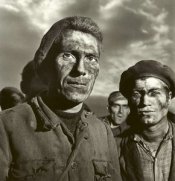Aye, listen, ye millionaires, listen!
Tread light o’er your carpeted floors,
And see the red flames as they glisten,
And hear the wild shout of the boors,
Or slaves, as you’ve long tried to make them,
Hark! hark! That dread sound’s drawing nigher.
Have you ventured at last to awake them
To spirits of vengeance and fire?
See! See! Your grand palace cars blazing!
They light up the mountains, and glen,
And see maddening labor uprising,
To crush down the robbers of men!
Tread light o’er your carpeted floors,
And see the red flames as they glisten,
And hear the wild shout of the boors,
Or slaves, as you’ve long tried to make them,
Hark! hark! That dread sound’s drawing nigher.
Have you ventured at last to awake them
To spirits of vengeance and fire?
See! See! Your grand palace cars blazing!
They light up the mountains, and glen,
And see maddening labor uprising,
To crush down the robbers of men!
Contributed by Bernart Bartleby - 2015/4/23 - 10:52
×
![]()
Note for non-Italian users: Sorry, though the interface of this website is translated into English, most commentaries and biographies are in Italian and/or in other languages like French, German, Spanish, Russian etc.







Canzone di autore anonimo dal “Great Railroad Strike of 1877”, anche noto come “Great Upheaval”.
Testo trovato su “The Encylopedia Of Strikes In American History”, a cura di Aaron Brenner, Benjamin Day ed Immanuel Ness, USA 2009.
Alla fine della Guerra Civile si verificò il boom delle costruzioni ferroviarie. Solo tra il 1866 ed il 1873 vennero posati 55.000 km di binari, coast to coast! I cantieri assorbivano quasi più lavoratori che in agricoltura. Il giro di investimenti ed il loro alto rischio erano abnormi, con l’esposizione diretta di banche ed istituti privati che però agivano spesso anche come agenzie governative. La bolla speculativa esplose con il “Panic of 1873”, la solita periodica crisi di “riaggiustamento strutturale” dei mercati, e naturalmente il botto travolse i lavoratori. Il taglio dei salari e il peggioramento repentino delle condizioni di lavoro e di vita portarono a grandi scioperi spontanei, non organizzati (i sindacati erano ancora da venire, il primo fu il marxista Workingmen's Party of the United States nel 1876) che dal West Virginia si diffusero in Maryland, Pennsylvania, Missouri ed Illinois.
Quello che non fecero i vigilantes delle compagnie ferroviarie lo fecero i soldati federali mandati, città per città, dal presidente Rutherford Birchard Hayes: gli scioperi furono schiacciati nel sangue, con decine di morti in ogni Stato.